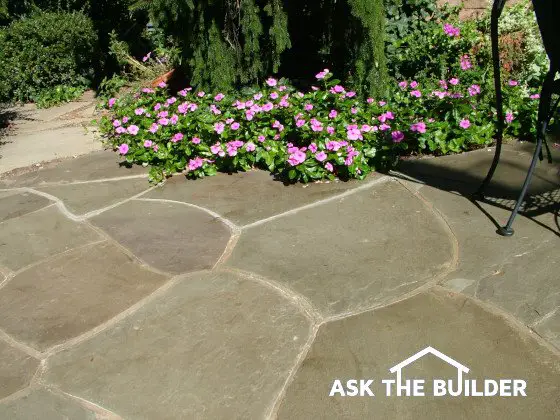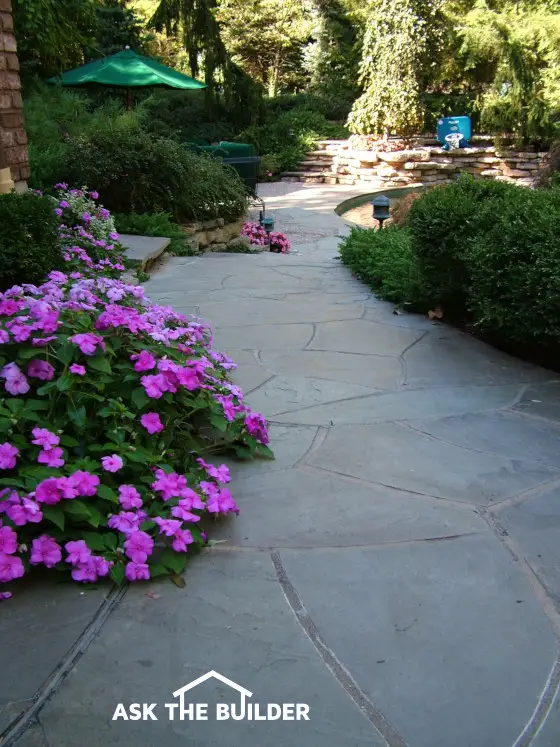Flagstone Patio Set on Sand

These flagstones are set on a concrete base. The stones have not budged in 13 years and I suspect they will still look swell 50 years from now.
DEAR TIM: Last fall a contractor installed a flagstone patio for me. He carefully laid the flat stones on a bed of sand and then grouted the spaces between the stones with mortar. Well, the flagstone are separating, the mortar is cracking and the patio is a mess. The contractor wants to put a layer of cement over the sand and start over. Will this work? If I had hired you, how would you have installed my flagstone patio? April W., Denver, CO
DEAR APRIL: Years ago the same thing happened to me. I installed thin paving brick on a sand bed that looked like a piece of glass it was so smooth. But ants, moles and freezing weather turned my brick sidewalk into a humpy-bumpy sand-covered disaster. Like me way back then, you are going to have to start over.
First remove and salvage the flagstone. Carefully chip off any mortar that is on the edges. Remove the sand and discard it unless you can be sure it is free of stones and dirt. If you can salvage it, much of it can be used to reinstall the flagstone but the sand will be mixed with Portland cement.
At this point you have two alternatives to solve your problem, although I am inclined to think that one of the methods is far better than the second. This first method, in my opinion, will produce a flagstone patio that can last 50 years or more without any cracks. Once you have determined the finish height of the patio, you need to excavate soil so that you can install a 4-inch thick concrete slab, 3/4 inch thick setting bed of cement mortar and the actual flagstones. Many flagstones are commonly 3/4 inch thick so I would excavate to a depth of 5.5 to 6 inches. Compact the soil at the bottom of the excavated area.
Pour a concrete slab in the excavated area that contains one-half inch steel reinforcing bars placed on two foot centers in both directions. This grid of steel needs to be suspended so that the steel ends up in the lower third of the concrete slab, but be sure that at least one and one-half inches of concrete is under the steel at all points. This steel has tremendous tensile strength and will prevent the slab from developing large cracks that cause the concrete to separate and tilt into separate planes.
To further strengthen the slab, you can dig vertical piers that are 6 inches in diameter and extend below the frost line in your area. These piers act like the legs on a table and help give the patio added support. To prevent the patio and the piers from heaving if frost starts to penetrate into the soil, make the bottom of the piers flare to 8 inches in diameter.

Curving the walkways and edges of the patio and then adding plants that flow over the stones makes for a luscious look.
When you pour the slab, it does not have to be finished smooth. The surface needs to be in the same plane, but it can be left very rough with holes and stones exposed. This rough texture will help hold the flagstones in place when they are set in wet cement mortar.
Within 24 hours of pouring the concrete slab, start to install the flagstones. Use a mixture of Portland cement and sand to permanently attach the flagstones to the concrete. Mix one part of cement to three parts sand. Coarse sand is better for this purpose as it contains pieces of rounded rock about 1/8 inch in diameter. This coarse sand makes a very strong mortar.
The mortar should be the consistency of regular bricklayer's mortar. Do not make it so dry that you have to pound the stones into place with a rubber mallet. If the mortar is just right, a small amount of pressure from your hands floats the flagstones into position. Once the flagstones have set for two days, you can fill the gaps between them with a similar mixture of medium sand and Portland cement.
A second alternative method of installing the patio is to remove the current sand and allow it to dry or become just slightly damp. Blend one part Portland cement with three parts of this sand and reinstall the sand base. Before you install the sand back into the excavated area, generously water the soil so it is very wet. Be sure you install the sand at least 3 inches thick. Level the sand and place the flagstones onto the sand and tamp them into place. Use a garden hose and a nozzle to finely mist the flagstones so that some water flows between the stones into the sand. Do this for perhaps 10 minutes.
Wait at least one week before walking onto the patio to fill the gaps between the stones with the Portland cement and sand mortar mix. This wait period will ensure the sand and cement base has time to harden. The sand base will be immune to attack from ants and moles, but it will not be sufficiently strong to withstand serious frost heaving and/or other soil movement.
The second method of mixing Portland cement with sand works, but it is not as good as the poured concrete base. Thirty years ago, I built my mother-in-law's patio using the sand and cement base method. The patio is in good shape today, but many of the brick are somewhat humpy and bumpy. She likes the look as it reminds her of weathered brick walks she has seen in Williamsburg, VA.
But her patio is different. There is no mortar between the brick. The brick are very uniform and stack closely against one another. There is a strong possibility that the cement mortar joints between individual flagstone that are laid on top of a sand / cement base may start to fall apart if the base starts to crack and shift.
There is very little extra work to install the concrete base. The only extra step is mixing the cement mortar that adheres the flagstone to the concrete slab. This is not as hard as it seems and can be done one wheelbarrow at a time.
Column 536
One Response to Flagstone Patio Set on Sand